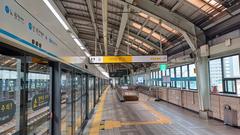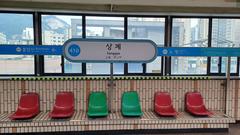
Sanggye Station Visiting Hours, Tickets, and Seoul Historical Sites Guide
Date: 14/06/2025
Introduction
Sanggye Station, located in Nowon-gu, northeastern Seoul, is much more than a subway stop on Line 4 of the Seoul Metropolitan Subway. As a key transportation hub, it provides convenient access to a range of historical, cultural, and natural attractions, while serving as an emblem of Seoul’s dynamic urban growth and community spirit. Whether you are a commuter, tourist, or culture seeker, this comprehensive guide will help you navigate Sanggye Station’s visiting hours, ticketing systems, accessibility features, and nearby landmarks—including the Sanggye-dong Ancient Fortress and Sanggye Monument—while offering practical travel tips and insights into ongoing urban regeneration projects.
Table of Contents
- Introduction
- Historical Evolution of Sanggye Station and Nowon-gu
- Sanggye Station Visitor Information
- Exploring Sanggye-dong Ancient Fortress
- Sanggye Monument and Local Culture
- Frequently Asked Questions (FAQ)
- Summary and References
Historical Evolution of Sanggye Station and Nowon-gu
Originally a rural settlement with agricultural roots, the area now known as Sanggye-dong in Nowon-gu underwent rapid urbanization following the Korean War. The official establishment of Nowon-gu in 1988, after its separation from Dobong-gu, marked a new era of high-density residential and infrastructural development (allsouthkorea.com).
The opening of Sanggye Station in 1985, as part of Seoul’s subway expansion, was instrumental in connecting the northern districts with central Seoul and catalyzing the area’s transformation into a vibrant urban environment (Wikipedia). The station’s presence spurred the growth of commercial centers, residential complexes, and public amenities, integrating the area into the city’s urban fabric.
Today, Sanggye is a showcase for sustainable urban regeneration, with projects like the Changdong-Sanggye Development Zone, future K-POP Arena, and new multi-modal transit centers aiming to blend culture, commerce, and connectivity (archdaily.com; Bustler).
Sanggye Station Visitor Information
Visiting Hours
Sanggye Station operates daily from approximately 5:30 AM to midnight, following Seoul Metro’s standard schedule. Timings may vary on weekends and public holidays; for precise times, check the Seoul Metro app or station information boards.
Tickets and Fares
- T-Money Card: The most convenient, rechargeable smart card for subways, buses, and select taxis. Purchase and top-up at stations or convenience stores. Fares start at 1,250 KRW and vary by distance (Hey Roseanne).
- Single Journey Ticket: Available from station vending machines—ideal for infrequent travelers.
- Mobile Payment: Increasingly accepted at gates and kiosks.
Accessibility
The station is equipped with elevators, escalators, tactile paving, and accessible restrooms. Signage is bilingual (Korean/English), and staff are available to assist, though English proficiency may vary (Living Nomads).
Travel Tips
- Peak hours: Avoid 7–9 AM and 6–8 PM for a more comfortable ride.
- Navigation apps: Use KakaoMap or Naver Map for accurate transit directions (Korea Travel Planning).
- Bicycle and pedestrian access: Bike racks and pedestrian-friendly paths are available (Living Nomads).
- Etiquette: Respect priority seating, queue properly, and keep noise to a minimum on trains.
Transportation and Connectivity
Sanggye Station connects to:
- Seoul Station (for KTX, ITX, and AREX trains to Incheon and Gimpo airports)
- Myeongdong (shopping district)
- Dongdaemun History & Culture Park
- Suraksan Mountain (nature/hiking, via Exit 1)
- Danghyeon Stream (walking trails and local festivals)
The station is also a transfer point for numerous city buses and, in the future, the Seoul Light Rail Transit Dongbuk Line (Namu Wiki).
Exploring Sanggye-dong Ancient Fortress
History and Cultural Significance
Dating back to the Joseon Dynasty, the Sanggye-dong Ancient Fortress was built as a military outpost to defend northern Seoul. Its stone walls and preserved structures offer insight into traditional Korean defensive architecture. The fortress is now a protected cultural heritage site, valued for its panoramic views and role in local history (Seoul Cultural Heritage Official Website).
Visiting Hours and Admission
- Open daily: 9:00 AM – 6:00 PM (last entry 5:30 PM)
- Closed: Major holidays (Lunar New Year, Chuseok)
- Admission: Free
Getting There and Accessibility
From Sanggye Station (Line 4, Exit 3), it’s a 10-minute walk via a scenic trail. The fortress is accessible for wheelchairs and strollers, with paved paths and braille/tactile signage. Limited parking is available; public transport is recommended.
Guided Tours and Events
Guided tours (in Korean and English) are available upon request and during special events. Seasonal festivals feature music and reenactments, especially in spring and autumn. Check schedules at Seoul Cultural Heritage Official Website.
Nearby Attractions
- Daeho Department Store: Shopping and dining
- Nowon Traditional Market: Local crafts and food
- Bukhansan National Park: Hiking and nature
Sanggye Monument and Local Culture
Monument Details and Visiting Info
The Sanggye Monument honors the district’s transformation from a relocated settlement into a thriving community. It is open daily from 9:00 AM to 6:00 PM, with free admission (last entry 5:30 PM). The site is wheelchair accessible and easily reached from Sanggye Station (Exit 2).
Local Life and Markets
- Buramsan Mountain: Popular for hiking; panoramic views (Seoul Sub→urban)
- Satgat Park: Community park for relaxation and local gatherings
- Sanggye Central Market: Traditional and modern market experience
- Danghyeon Stream: Urban stream with walking trails and seasonal beauty
Social and Nightlife
The area around Sanggye Station features local bars, restaurants, and karaoke rooms (noraebang), reflecting the district’s vibrant, communal culture (Offvisa).
Future Developments
Sanggye is at the center of major urban regeneration projects:
- Changdong·Sanggye Start-up and Culture Industry Complex: Supporting new businesses and cultural events (Bustler)
- K-POP Arena: Large-scale entertainment venue under construction
- Transit upgrades: New rail lines and eco-friendly infrastructure (Seoul Metropolitan Government)
- Preservation initiatives: Balancing modernization with heritage protection (Seoul Sub→urban)
Frequently Asked Questions (FAQ)
Q: What are Sanggye Station’s operating hours?
A: 5:30 AM to midnight; check for updates on holidays.
Q: How do I buy tickets?
A: Use T-Money cards, single journey tickets, or mobile payment at station kiosks and convenience stores.
Q: Is the station accessible?
A: Yes, with elevators, escalators, and tactile paving.
Q: What historical sites are nearby?
A: Sanggye-dong Ancient Fortress, Sanggye Monument, Buramsan Mountain, and local markets.
Q: Are guided tours available?
A: Yes, at the fortress and monument (check schedules for English tours).
Summary
Sanggye Station is a dynamic entry point to Seoul’s history, culture, and urban life. It offers easy connections to iconic attractions, accessible transit options, and a glimpse of both modern regeneration and preserved tradition. With user-friendly ticketing, clear signage, and robust local amenities, Sanggye is an excellent starting point for exploring northeastern Seoul.
For the latest updates, download the Audiala app and visit the official resources listed below.
References and Useful Links
- Discovering Seoul’s Nowon-gu: A Guide for Foreign Travelers (allsouthkorea.com)
- Nowon Station – Wikipedia
- International Design Competition for the Changdong Station Transit Complex Center – archdaily.com
- A Place Ideal for Strolling at the Noeul Moonlight Festival Along Danghyeoncheon in Nowon – koreantraveller.com
- Seoul: Brief Insight into Its History and Urban Development – academia.edu
- Seoul Cultural Heritage Official Website
- Sanggye Station – Namu Wiki
- Seoul Subway Guide (2024) – LivingNomads.com
- Seoul Travel Guide – Hey Roseanne
- Transportation in Korea – Korea Travel Planning
- Changdong·Sanggye Start-up and Culture Industry Complex – Bustler.net
- Regeneration of Residential Areas – Seoul Metropolitan Government
- Sanggye Station Line 4 – Seoul Sub→urban Blog
- 13 Things to Know Before Visiting Seoul – Offvisa.com














































































































































































































